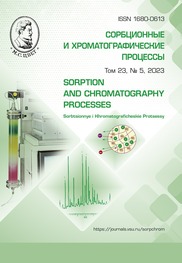Study of sorption of platinum, palladium and rhodium ions on a carbon sorbent
Abstract
The article is devoted to the sorption concentration of platinum (II,IV), palladium (II) and rhodium (III) ions from chloride media on a carbon synthetic sorbent. For the study of the sorption concentration of platinum group metals, the carbon synthetic sorbent Lewatit AF5 was chosen. This sorbent has high mechanical strength, high surface area, narrow pore size distribution, and low cost compared to silicate or polymer sorbents.
Sorption concentration was carried out under static conditions from model chloride solutions. The concentration of analytes in the initial solutions ranged from 8 to 50 mmol/dm3. Equilibrium concentrations of metals in solutions were determined by inductively coupled plasma atomic emission spectrometry. The dependences of adsorption on contact time, free acidity and redox potential of the system were studied, and the limiting absorption values for each of the metals studied were determined.
The study of the kinetic parameters of the sorption of Pt (IV), Pd (II) and Rh (III) ions was carried out from chloride solutions characterized by free acidity values of 0.01 mol/dm3. The time for establishing sorption equilibrium was determined, which was 4 hours for each of the ions. When studying the dependence of adsorption on free acidity and the oxidation-reduction potential of the system (ORP), it was revealed that with an increase in free acidity and redox potential, a decrease in sorption activity is observed, thus we can conclude that aquated complexes of platinum metals, in which metals present not in the highest oxidation state, involved in the sorption process.
Processing of experimental data showed the applicability of the linear equation of the Langmuir isotherm for the description of the adsorption process, the limiting adsorption values were calculated, using which the sorption capacity of the sorbent was assessed. The sorption capacity for Pt (II, IV), Pd (II) and Rh (III) was 1.24 mmol/g; 1.16 mmol/g and 0.57 mmol/g, respectively. High values of sorption capacity, as well as a fairly short time to achieve sorption equilibrium without the use of means for the acceleration of the process, in combination with the mechanical characteristics of the sorbent, allow us to conclude that the Lewatit AF5 sorbent is promising for the concentration of platinum group metals from hydrochloric acid solutions.
Downloads
References
Izatt S.R., Bruening R.L., Izatt N.E. Metal separations and recovery in the min-ing industry. Journal of the minerals metals & materials society. 2012; 64(11): 1279-1284. https://doi.org/10.1007/s11837-012-0452-8
Baryshnikov I.F., Popova N.N., Orobinskaja V.A. Probootbiranie i analiz blagorodnyh metallov. M., Metallurgija, 1978, 430 p.
Pechenyuk S.I. Sorbtsionno-gidroliticheskoe osazhdenie platinovykh metallov na poverkhnosti neorganicheskikh sorbentov. Leningrad, Nauka, 1991, 246 p.
Malofeeva G.I., Petrukhin O.M., Murinov Yu.I., Zolotov Yu.A. Geterotsepnye polimery – kompleksoobrazuyushchie sorbenty novogo tipa.Izvestiya VUZov. Khimiya i khimicheskaya tekhnologiya, 1988; 31(5): 3-14. (In Russ.)
Vasil'eva I.E., Pozhidaev Yu.N., Vlasova N.N., Voronkov M.G., Filipchenko Yu.A. Sorbtsionno-atomno-emissionnoe opredelenie zolota, platiny i palladiya v gornykh porodakh i rudakh s ispol'zovaniem sorbenta PSTM-ZT, Anali-tika i kontrol', 2010; 14(1): 16-24. (In Russ.)
Losev V.N., Buiko O.V., Velichko B.A. Sorbtsionno-atomno-emissionnoe opredelenie tsvetnykh i tyazhelykh metallov s ispol'zovaniem fitosorbentov. Journal of Siberian Federal University, 2010; 3: 73-78. (In Russ.)
Zolotov Yu.A., Tsizin G.I., Dmitrien-ko S.G., Morosanova E.I. Sorbtsionnoe kontsentrirovanie mikrokomponentov iz rastvorov. Primenenie v neorganicheskom analize. M., Nauka, 2007, 320 p.
Myasoedova G.V., Komozin P.N. Kompleksoobrazuyushchie sorbenty dlya izvlecheniya i kontsentrirovaniya platinovykh metallov, Zhurnal neorganicheskoi khimii, 1994; 39(2): 280-288. (In Russ.)
Runov V.K., Strepetova T.V., Pu-khovskaya V.M., Trofimchuk A.K., Kuz'min N.M. Sorbtsiya khloridnykh kompleksov platinovykh metallov i zolota anionoobmennikami na osnove kremnezema. Zhurnal analiticheskoi khimii, 1993; 48(11): 43-49. (In Russ.)
Milyutina A.D., Kolesnikov V.A., Kolesnikov A.V. Sorbtsionnye kharakteris-tiki uglerodnykh nanomaterialov po otnosheniyu k ionam Cu2+, Ni2+, Zn2+, Co2+, Fe2+. Uspekhi v khimii i khimicheskoi tekhnologii, 2016; 30(1): 42-43. (In Russ.)
Dudareva G.N., Irinchinova N.V., Dudarev V.I., Petukhova G.A. izuchenie sorbtsionnogo izvlecheniya nikelya(II) iz vodnykh rastvorov. Fizikokhimiya poverkhnosti i zashchita materialov. 2019; 55(5): pp. 488-495.
Slavinskaya G.V., Kovaleva O.V., Bychkovskaya G.I. Ispol'zovanie aktivnykh uglei sorbtsii PAV prirodnogo proiskhozhdeniya. Sorbtsionnye i khromatograficheskie protsessy. 2008; 8(4): 626-635. (In Russ.)
Golovizin V.S., Levchenko L.M., Trubin S.V. Salanov A.N., Serkova A.N. Sorbtsiya platinokhloristovodorodnoi kisloty modifitsirovannymi uglerodnymi materialami. Vestnik MITKhT. 2012; 7(1): 23-28. (In Russ.)
Tarasenko Yu.A., Bagreev A.A., Yatsenko V.V. Selektivnost' vosstanovitel'noi sorbtsii blagorodnykh metallov aktivnymi uglyami. Zhurnal fizicheskoi khimii. 1993; 67(11): 2328-2332.
Van Dam H.E., Van Bekkum H. Preparation of platinum on activated car-bon. Journal of Catalysis. 1991; 131(2): 335-349. https://doi.org/10.1016/0021-9517(91)90269-A
Ageeva L.D., Buinovskii A.S., Kolpakova N.A., Kovyrkina T.V. Sovmestnoe opredelenie v rudakh i kontsentratakh zolota, serebra i metallov platinovoi gruppy. Seversk, SGTI, 2003, 99 p. (In Russ.)
Romanenko A.V., Simonov P.A. Uglerodnye materialy i ikh fiziko-khimicheskie svoistva. M., Kalvis, 2007, 128 p. (In Russ.)
Nikoloski A.N., Kwang-Loon Ang. Review of the application of ion-exchange resins for the recovery of platinum-group metals from hydrochloric acid solutions. Journal of mineral processing and extractive metallurgy review. 2014; 35(6): 369-389. https://doi.org/10.1080/08827508.2013.764875
Zolotov Yu.A., Varshal G.M., Ivanov V.M. Analiticheskaya khimiya metallov platinovoi gruppy. M., Editorial URSS, 2003, 592 p. (In Russ.)







